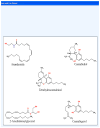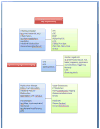Cannabinoid hyperemesis syndrome
- PMID: 22150623
- PMCID: PMC3576702
- DOI: 10.2174/1874473711104040241
Cannabinoid hyperemesis syndrome
Abstract
Coinciding with the increasing rates of cannabis abuse has been the recognition of a new clinical condition known as Cannabinoid Hyperemesis Syndrome. Cannabinoid Hyperemesis Syndrome is characterized by chronic cannabis use, cyclic episodes of nausea and vomiting, and frequent hot bathing. Cannabinoid Hyperemesis Syndrome occurs by an unknown mechanism. Despite the well-established anti-emetic properties of marijuana, there is increasing evidence of its paradoxical effects on the gastrointestinal tract and CNS. Tetrahydrocannabinol, cannabidiol, and cannabigerol are three cannabinoids found in the cannabis plant with opposing effects on the emesis response. The clinical course of Cannabinoid Hyperemesis Syndrome may be divided into three phases: prodromal, hyperemetic, and recovery phase. The hyperemetic phase usually ceases within 48 hours, and treatment involves supportive therapy with fluid resuscitation and anti-emetic medications. Patients often demonstrate the learned behavior of frequent hot bathing, which produces temporary cessation of nausea, vomiting, and abdominal pain. The broad differential diagnosis of nausea and vomiting often leads to delay in the diagnosis of Cannabinoid Hyperemesis Syndrome. Cyclic Vomiting Syndrome shares several similarities with CHS and the two conditions are often confused. Knowledge of the epidemiology, pathophysiology, and natural course of Cannabinoid Hyperemesis Syndrome is limited and requires further investigation.
Figures


References
-
- United States Department of Health and Human Services. Substance Abuse and Mental Health Services Administration. Office of Applied Studies. National Survey on Drug Use and Health. ICPSR29621-v1. Ann Arbor, MI: Inter-university Consortium for Political and Social Research [distributor]; 2009. 2010-11-16. - DOI
-
- Foley JD. Adolescent use and misuse of marijuana. Adolesc Med Clin. 2006;17:319–34. - PubMed
-
- European Monitoring Centre of Drugs and Drug Addiction. Annual report 2006: the state of the drugs problem in Europe. Report No: 92-9168-266-7. Office for Official Publications of the European Communities; Luxembourg:
-
- Compton WM, Grant BF, Colliver JD, et al. Prevalence of marijuana use disorder in the United States: 1991–1992 and 2001–2002. JAMA. 2004;291:2214–21. - PubMed
-
- Stinson FS, Ruan WJ, Pickering R, et al. Cannabis use disorders in the USA: prevalence, correlates and co-morbidity. Psychol Med. 2006;36:1447–60. - PubMed
Publication types
MeSH terms
Substances
Supplementary concepts
Grants and funding
LinkOut - more resources
Full Text Sources
Other Literature Sources
Medical
